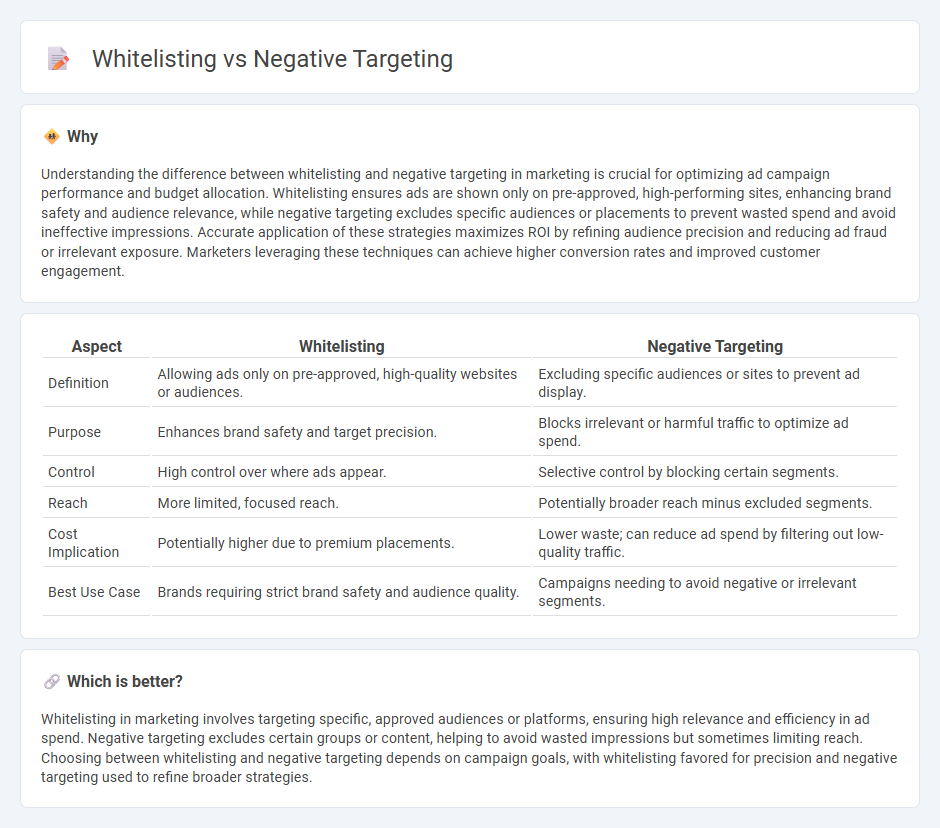
Whitelisting in marketing refers to allowing specific audiences or platforms to access your ads, ensuring highly targeted and relevant campaign delivery, while negative targeting excludes particular groups or sites to avoid wasting budget on uninterested users. These strategies optimize ad spend and improve engagement by refining who sees your message based on predefined criteria. Explore more to understand how to leverage whitelisting and negative targeting for maximizing marketing ROI.
Why it is important
Understanding the difference between whitelisting and negative targeting in marketing is crucial for optimizing ad campaign performance and budget allocation. Whitelisting ensures ads are shown only on pre-approved, high-performing sites, enhancing brand safety and audience relevance, while negative targeting excludes specific audiences or placements to prevent wasted spend and avoid ineffective impressions. Accurate application of these strategies maximizes ROI by refining audience precision and reducing ad fraud or irrelevant exposure. Marketers leveraging these techniques can achieve higher conversion rates and improved customer engagement.
Comparison Table
| Aspect | Whitelisting | Negative Targeting |
|---|---|---|
| Definition | Allowing ads only on pre-approved, high-quality websites or audiences. | Excluding specific audiences or sites to prevent ad display. |
| Purpose | Enhances brand safety and target precision. | Blocks irrelevant or harmful traffic to optimize ad spend. |
| Control | High control over where ads appear. | Selective control by blocking certain segments. |
| Reach | More limited, focused reach. | Potentially broader reach minus excluded segments. |
| Cost Implication | Potentially higher due to premium placements. | Lower waste; can reduce ad spend by filtering out low-quality traffic. |
| Best Use Case | Brands requiring strict brand safety and audience quality. | Campaigns needing to avoid negative or irrelevant segments. |
Which is better?
Whitelisting in marketing involves targeting specific, approved audiences or platforms, ensuring high relevance and efficiency in ad spend. Negative targeting excludes certain groups or content, helping to avoid wasted impressions but sometimes limiting reach. Choosing between whitelisting and negative targeting depends on campaign goals, with whitelisting favored for precision and negative targeting used to refine broader strategies.
Connection
Whitelisting in marketing involves allowing ads to appear only on pre-approved websites or audiences, ensuring brand safety and optimal reach. Negative targeting excludes specific demographics or placements to prevent budget waste and ad fatigue. Together, these strategies refine ad delivery by combining selective inclusion with strategic exclusion, maximizing campaign efficiency and ROI.
Key Terms
Exclusion Criteria
Negative targeting excludes specific audiences based on predefined criteria, enhancing ad relevance by preventing ads from reaching uninterested users, while whitelisting restricts campaign delivery solely to approved segments or sites. This exclusion strategy in negative targeting maximizes budget efficiency by filtering out unwanted impressions, whereas whitelisting offers higher precision at the risk of reduced reach. Explore how fine-tuning these exclusion criteria can optimize your digital marketing campaigns.
Allowed List
Negative targeting excludes specific audiences or criteria to prevent ad delivery to undesired groups, while whitelisting, or using an Allowed List, explicitly permits only pre-approved audiences or placements for ad exposure. Whitelisting ensures higher precision and brand safety by restricting ads to trusted channels or demographics, enhancing campaign effectiveness and control. Explore how leveraging Allowed Lists can optimize your ad strategy and improve ROI.
Audience Segmentation
Negative targeting excludes specific audience segments based on attributes like demographics, behaviors, or interests, improving ad relevance by avoiding uninterested users. Whitelisting involves selecting only predetermined, high-value audience segments or publishers to maximize ad effectiveness and brand safety. Explore how strategic audience segmentation with these methods can optimize campaign performance and ROI.
Source and External Links
Negative Targeting - This feature allows excluding keywords and product pages to avoid irrelevant traffic, enhancing targeting precision in advertising campaigns.
Amazon PPC Negative Keywords - Negative keywords help refine audience targeting by preventing ads from appearing for irrelevant search terms, thus optimizing ad spend.
Amazon Negative Keyword Targeting - This approach uses negative phrase and exact match keywords to exclude unwanted search queries, ensuring advertisements reach relevant audiences more effectively.
 dowidth.com
dowidth.com